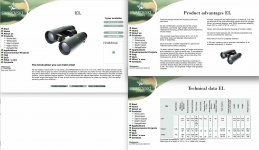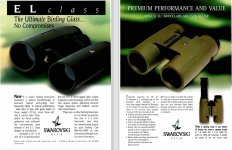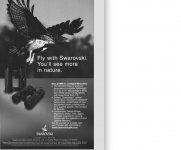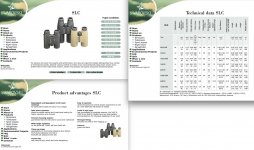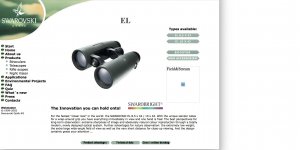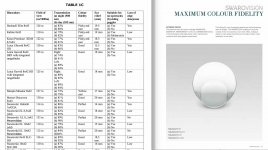Hi John (posts #21, 22),
I have magazines, catalogs, and optics reviews from that time period in my files, so last night I dug out a few to have a look and stroll down memory lane. What I found matches my recollections from my post yesterday and--as you found in the Swarovski online catalog of the time--doesn't definitively settle the question, but it is at least consistent with my notion that the EL has always had dielectric coatings that were later named Swarobright. In looking at those materials from around the time the EL was released, what immediately struck me was that advertising and even most reviews were not filled with specifications or technical details. No one was talking about dielectric coatings [The earliest uses of "dielectric" that I find on BirdForum were not until 2004]. In 1999, Swarovski wasn't as well known or respected amongst birders as Zeiss, Leica, and Nikon. Swarovski bins were tough and "a good value" (cheaper than Zeiss, Leica, and Nikon's best) but were plagued with a strong yellow tint to the view. The tint was really obvious when comparing my Zeiss 7x42 BGATP to my friends' Swarovski 7x42 and 10x42 SLC bins, but comparison wasn't necessary to see it. Word was that it was a benefit for hunting. I couldn't tolerate it for birding. Then, in 1999, the EL were released, and besides having a new ergonomic body shape (designed, in my opinion, to mimic the Zeiss 7x42 and to appeal to users like me) it was a big deal for two other things, (1) being the first Swarovski with neutral color, and (2) being the first standard sized birding binocular to be successfully priced well over $1000--as I recall, ~$1350 [Nikon tried to do that with the Venturer LX but it soon dropped to around $900].
I've attached a PDF copy of Steve Ingraham's review of the EL in Better View Desired. Note that he commented on the neutral color and the brightness (the transmission, not the "apparent brightness) of the EL. He also described and rightly criticized its slow focus action.
I've also attached a PDF of the Swarovski pages of the Eagle Optics Buying Guide volume 12#5 of 1999 (pp. 1-2 of the PDF), volume 13#1 of 2000 (p. 3 of the PDF), and volume 14#1 of 2001 (pp. 5-6 of the PDF). The content is, it seems, mostly borrowed from Swarovski marketing materials. Note that in 1999 the EL was described as having "absolutely natural color reproduction". For anyone in the know, those words jumped off the page. Note also that in 2001, all the SLC binoculars are described as "now coated with the same Swarobright coatings as used in the EL models" and Swarobright is simply listed as a feature of (not a new feature or update to) the EL which implied to me that the EL always had it since there was never any announcement by Swarovski or any observation by binocular enthusiasts that the EL had ever been upgraded (Nor have I ever seen evidence of such myself even though I have looked through many early and later units of the EL).
The neutral color of the EL was a big deal because it wiped away the biggest complaint that I and many other birders might have had with the binocular and with Swarovski generally. So it seems that Swarovski took the color issue seriously and over the next few years updated the lens coatings of the SLC models to give them neutral color. Consequently, Swarovski's popularity rocketed upward. Did that change to the SLC lens coatings occur simultaneously with introduction of dielectric prism coatings and with use of the trademark label Swarobright? That's how it seemed at the time. My recollection, and what I found on reviewing adverts and catalog pages, is that when the SLC models were updated to Swarobright, that the improvement was advertised as bringing them up to the standard already seen in the EL. I don't remember anyone discussing pre-Swarobright EL binoculars at the time nor afterward, but the relative desirability of pre- versus post-Swarobright SLC bins is well known. Later, when the focus speed of the EL was updated, the update was noted by Swarovski and was a well-known concern for buyers of used EL bins. It seems to me that Swarovski introduced neutral color balance lens coatings and dielectric prism coatings with the initial release of the EL, then later invented the advertising trademark Swarobright to bring attention to use of those same coatings in the updated SLC binoculars. In fact, I won't be surprised if it is the case that those improvements to the SLC were also made prior to the use of the Swarobright label. The label really did effectively advertise the change in the SLC and help Swarovski squash the notion that the otherwise-great-for-birding tough SLC bins would always (intentionally) have a yellow tint since they were really designed for hunters.
Finally, just for fun and veering somewhat from the main topic, I've attached a PDF compiling all the Swarovski advertisements from 1994-2006 in Birding, the magazine of the American Birding Association. This covers the time period when Swarovski rose from obscurity or at least a junior position in terms of prestige and brand recognition amongst birders to being the dominant brand. All in all, the adverts are quite conservative, yet it is clear that someone at Swarovski decided in about 1993 to doggedly advertise very prominently so as to get birders to take notice of the brand and build its reputation. From Aug 1994 until Dec 2003, the Swarovski advert was always a full page and always on page 1 of the magazine (Earlier, e.g. in 1993, the first page of Birding was variously a full page advert for Bausch & Lomb, Zeiss, Nikon, Leica, or Swarovski binoculars).
Sorry I'm too lazy to insert my comments within the PDF itself, but the following are my observations. Keep in mind that Birding consisted of 6 issues a year, initially coming out in Feb, April, June, Aug, Oct, Dec and later in Jan/Feb, March/April, May/June, July/Aug, Sept/Oct, and Nov/Dec.
PDF page; issue; comments
1. 1994 Aug - "New Swarovski SLC MK III Binocular. The Value Class." This advert, emphasizing the competitive price of these bins, ran on page 1 of every issue until it was replaced by...
2. 1995 Feb - "Swarovski Family Values", which also emphasized value, ran on p. 1 of every issue until...
3. 1996 Feb - "The Ultimate Ice & Water Glass" advert promoted Swaro bins as being rugged. It ran on p. 1 until...
4. 1997 Feb -"Two for the birds". This was a cooperative joint promo for Swarovski and Victor Emanuel Nature Tours. Importantly, it allies Swarovski specifically with birding. It ran on p. 1 of every issue for nearly 2 years!, finally being replaced with a return to...
5. 1998 Oct -"The Ultimate Ice & Water Glass", also on p. 1, but then two issues later, another birding alliance...
6. 1999 Feb - "Sapsuckers' delight", this time connecting Swarovski to the Cornell Lab of Ornithology on p. 1 of every issue that year until with...
7. 2000 Feb - "EL class. The ultimate hunting glass..." we have the epic announcement of the EL binoculars, but someone messed up and sent a version meant for hunters! "Neutral color transmission" were the words that caught my attention, along with the shape. This ran on p. 1 and was replaced the following issue with...
8. 2000 Apr - "EL class. The ultimate birding glass..." which was the same ad otherwise, and it ran on p. 1 for over a year until it was replaced with...
9. 2000 Oct -"Premium performance and value: newest SLC binoculars are even better" which is intriguing because besides the change in rubber armor it says these have "Newest, phase-correcting, roof-prism coatings and mirror technology..." which is suggestive of dielectric coatings, but the proprietary name in question is not used. This ran on p. 1 of every issue until the return to...
10. 2001 Aug - "EL class. The ultimate birding glass..." a slightly modified version of the earlier advert, on p. 1 for a month, then finally...
11. 2001 Oct - "Swarobright" is announced! The advert says "Like our renowned EL binoculars, the new SLC class of 42, 50 and 56 mm binoculars incorporate...Swarobright". This seems to be a retroactive announcement, naming Swarobright as being what was special about the EL all along and also suggesting that the change in the SLC occurred with the updated SLC that were the subject of the advert of October 2000 (above). This ran on p. 1 until...
12. 2002 Apr - "Swarovski ATS & STS 65 mm spotting scopes" which ran on p. 1 until...
13. 2002 Oct - "Tough choice" which goes all out with the trademarked names, mentioning Swarobright, Swarotop, and Swarodur coatings. This ran on p. 1 for a year, finally being replaced with...
14. 2003 Oct - "Fly with Swarovski" which announced the x32 mm EL bins. Something seems to have changed with Swarovski's advertising priorities after this. This advert ran on p. 1 until Feb 2004, when it moved to the back outside cover, breaking the first page tradition after 9 years. Then the same advert moved to p. 7 (June), p. 29 (Aug), p. 3 (Oct), p. 7 (Jan/Feb), p. 13 (Mar/Apr), p. 21 (May/Jun), p. 9 (July/Aug & Sept/Oct) until it was finally replaced with...
15. 2005 Nov/Dec -"Swarovski Optik..." an advert that emphasized Austrian manufacture and which ran for only one issue, on p. 3. Amazingly, after its long advertising campaign, Swarovski had no adverts in the Jan/Feb and March/April of 2006 issues. No more need for advertising, given Swaro's dominant position among premium brands by that time? But the EL returned as
16. 2006 May/June - "Companion" Note that this is an ad for the EL, not the binoculars of the later Companion series. Also note the confidence of this ad, which is so minimalist it says almost nothing. It ran on p. 9. After that, Swarovski really seems to have lost most interest in advertising in Birding. In 2007, it ran a very inconspicuous 1/2 page ad "Observe & record" about digiscoping, somewhere in each issue.
I'll stop here.
--AP

